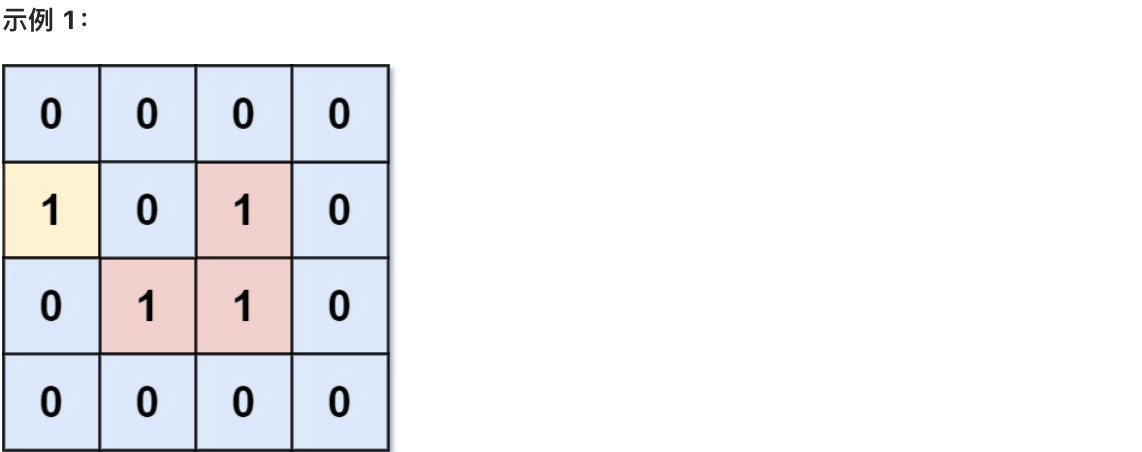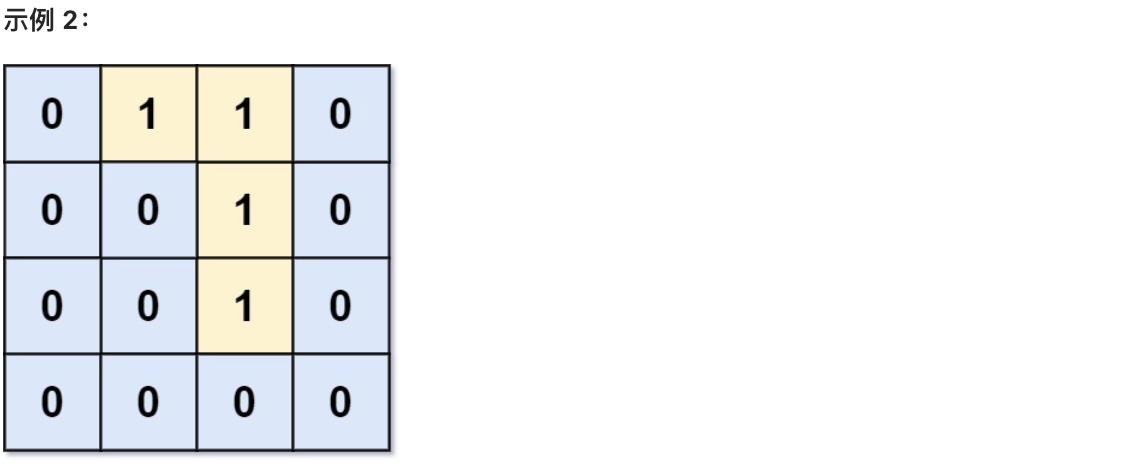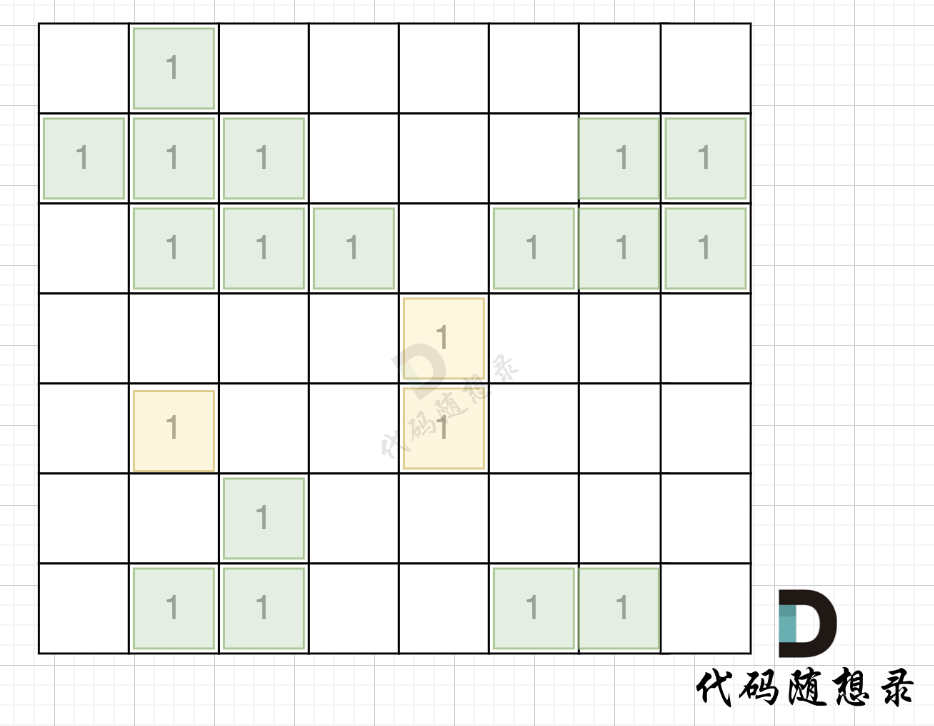参与本项目,贡献其他语言版本的代码,拥抱开源,让更多学习算法的小伙伴们收益!
# 1020. 飞地的数量
给你一个大小为 m x n 的二进制矩阵 grid ,其中 0 表示一个海洋单元格、1 表示一个陆地单元格。
一次 移动 是指从一个陆地单元格走到另一个相邻(上、下、左、右)的陆地单元格或跨过 grid 的边界。
返回网格中 无法 在任意次数的移动中离开网格边界的陆地单元格的数量。

- 输入:grid = [[0,0,0,0],[1,0,1,0],[0,1,1,0],[0,0,0,0]]
- 输出:3
- 解释:有三个 1 被 0 包围。一个 1 没有被包围,因为它在边界上。

- 输入:grid = [[0,1,1,0],[0,0,1,0],[0,0,1,0],[0,0,0,0]]
- 输出:0
- 解释:所有 1 都在边界上或可以到达边界。
# 思路
本题使用dfs,bfs,并查集都是可以的。
本题要求找到不靠边的陆地面积,那么我们只要从周边找到陆地然后 通过 dfs或者bfs 将周边靠陆地且相邻的陆地都变成海洋,然后再去重新遍历地图的时候,统计此时还剩下的陆地就可以了。
如图,在遍历地图周围四个边,靠地图四边的陆地,都为绿色,

在遇到地图周边陆地的时候,将1都变为0,此时地图为这样:

然后我们再去遍历这个地图,遇到有陆地的地方,去采用深搜或者广搜,边统计所有陆地。
如果对深搜或者广搜不够了解,建议先看这里:深度优先搜索精讲 (opens new window),广度优先搜索精讲 (opens new window)。
采用深度优先搜索的代码如下:
class Solution {
private:
int dir[4][2] = {-1, 0, 0, -1, 1, 0, 0, 1}; // 保存四个方向
int count; // 统计符合题目要求的陆地空格数量
void dfs(vector<vector<int>>& grid, int x, int y) {
grid[x][y] = 0;
count++;
for (int i = 0; i < 4; i++) { // 向四个方向遍历
int nextx = x + dir[i][0];
int nexty = y + dir[i][1];
// 超过边界
if (nextx < 0 || nextx >= grid.size() || nexty < 0 || nexty >= grid[0].size()) continue;
// 不符合条件,不继续遍历
if (grid[nextx][nexty] == 0) continue;
dfs (grid, nextx, nexty);
}
return;
}
public:
int numEnclaves(vector<vector<int>>& grid) {
int n = grid.size(), m = grid[0].size();
// 从左侧边,和右侧边 向中间遍历
for (int i = 0; i < n; i++) {
if (grid[i][0] == 1) dfs(grid, i, 0);
if (grid[i][m - 1] == 1) dfs(grid, i, m - 1);
}
// 从上边和下边 向中间遍历
for (int j = 0; j < m; j++) {
if (grid[0][j] == 1) dfs(grid, 0, j);
if (grid[n - 1][j] == 1) dfs(grid, n - 1, j);
}
count = 0;
for (int i = 0; i < n; i++) {
for (int j = 0; j < m; j++) {
if (grid[i][j] == 1) dfs(grid, i, j);
}
}
return count;
}
};
1
2
3
4
5
6
7
8
9
10
11
12
13
14
15
16
17
18
19
20
21
22
23
24
25
26
27
28
29
30
31
32
33
34
35
36
37
38
39
40
41
42
2
3
4
5
6
7
8
9
10
11
12
13
14
15
16
17
18
19
20
21
22
23
24
25
26
27
28
29
30
31
32
33
34
35
36
37
38
39
40
41
42
采用广度优先搜索的代码如下:
class Solution {
private:
int count = 0;
int dir[4][2] = {0, 1, 1, 0, -1, 0, 0, -1}; // 四个方向
void bfs(vector<vector<int>>& grid, int x, int y) {
queue<pair<int, int>> que;
que.push({x, y});
grid[x][y] = 0; // 只要加入队列,立刻标记
count++;
while(!que.empty()) {
pair<int ,int> cur = que.front(); que.pop();
int curx = cur.first;
int cury = cur.second;
for (int i = 0; i < 4; i++) {
int nextx = curx + dir[i][0];
int nexty = cury + dir[i][1];
if (nextx < 0 || nextx >= grid.size() || nexty < 0 || nexty >= grid[0].size()) continue; // 越界了,直接跳过
if (grid[nextx][nexty] == 1) {
que.push({nextx, nexty});
count++;
grid[nextx][nexty] = 0; // 只要加入队列立刻标记
}
}
}
}
public:
int numEnclaves(vector<vector<int>>& grid) {
int n = grid.size(), m = grid[0].size();
// 从左侧边,和右侧边 向中间遍历
for (int i = 0; i < n; i++) {
if (grid[i][0] == 1) bfs(grid, i, 0);
if (grid[i][m - 1] == 1) bfs(grid, i, m - 1);
}
// 从上边和下边 向中间遍历
for (int j = 0; j < m; j++) {
if (grid[0][j] == 1) bfs(grid, 0, j);
if (grid[n - 1][j] == 1) bfs(grid, n - 1, j);
}
count = 0;
for (int i = 0; i < n; i++) {
for (int j = 0; j < m; j++) {
if (grid[i][j] == 1) bfs(grid, i, j);
}
}
return count;
}
};
1
2
3
4
5
6
7
8
9
10
11
12
13
14
15
16
17
18
19
20
21
22
23
24
25
26
27
28
29
30
31
32
33
34
35
36
37
38
39
40
41
42
43
44
45
46
47
48
49
2
3
4
5
6
7
8
9
10
11
12
13
14
15
16
17
18
19
20
21
22
23
24
25
26
27
28
29
30
31
32
33
34
35
36
37
38
39
40
41
42
43
44
45
46
47
48
49
# 其他语言版本
# Java
深度优先遍历(没有终止条件 + 空間優化(淹沒島嶼,沒有使用visited數組))
//DFS
class Solution {
int count = 0;
int[][] dir ={
{0, 1},
{1, 0},
{-1, 0},
{0, -1}
};
private void dfs(int[][] grid, int x, int y){
if(grid[x][y] == 0)
return;
grid[x][y] = 0;
count++;
for(int i = 0; i < 4; i++){
int nextX = x + dir[i][0];
int nextY = y + dir[i][1];
if(nextX < 0 || nextY < 0 || nextX >= grid.length || nextY >= grid[0].length)
continue;
dfs(grid, nextX, nextY);
}
}
public int numEnclaves(int[][] grid) {
for(int i = 0; i < grid.length; i++){
if(grid[i][0] == 1)
dfs(grid, i, 0);
if(grid[i][grid[0].length - 1] == 1)
dfs(grid, i, grid[0].length - 1);
}
//初始化的時候,j 的上下限有調整過,必免重複操作。
for(int j = 1; j < grid[0].length - 1; j++){
if(grid[0][j] == 1)
dfs(grid, 0, j);
if(grid[grid.length - 1][j] == 1)
dfs(grid, grid.length - 1, j);
}
count = 0;
for(int i = 1; i < grid.length - 1; i++){
for(int j = 1; j < grid[0].length - 1; j++){
if(grid[i][j] == 1)
dfs(grid, i, j);
}
}
return count;
}
}
1
2
3
4
5
6
7
8
9
10
11
12
13
14
15
16
17
18
19
20
21
22
23
24
25
26
27
28
29
30
31
32
33
34
35
36
37
38
39
40
41
42
43
44
45
46
47
48
49
50
51
52
2
3
4
5
6
7
8
9
10
11
12
13
14
15
16
17
18
19
20
21
22
23
24
25
26
27
28
29
30
31
32
33
34
35
36
37
38
39
40
41
42
43
44
45
46
47
48
49
50
51
52
深度优先遍历(没有终止条件)
class Solution {
// 四个方向
private static final int[][] position = {{-1, 0}, {0, 1}, {1, 0}, {0, -1}};
// 深度优先遍历,把可以通向边缘部分的 1 全部标记成 true
public void dfs(int[][] grid, int row, int col, boolean[][] visited) {
for (int[] current: position) {
int newRow = row + current[0], newCol = col + current[1];
// 下标越界直接跳过
if (newRow < 0 || newRow >= grid.length || newCol < 0 || newCol >= grid[0].length) continue;
// 当前位置不是 1 或者已经被访问了就直接跳过
if (grid[newRow][newCol] != 1 || visited[newRow][newCol]) continue;
visited[newRow][newCol] = true;
dfs(grid, newRow, newCol, visited);
}
}
public int numEnclaves(int[][] grid) {
int rowSize = grid.length, colSize = grid[0].length, ans = 0; // ans 记录答案
// 标记数组记录每个值为 1 的位置是否可以到达边界,可以为 true,反之为 false
boolean[][] visited = new boolean[rowSize][colSize];
// 左侧边界和右侧边界查找 1 进行标记并进行深度优先遍历
for (int row = 0; row < rowSize; row++) {
if (grid[row][0] == 1 && !visited[row][0]) {
visited[row][0] = true;
dfs(grid, row, 0, visited);
}
if (grid[row][colSize - 1] == 1 && !visited[row][colSize - 1]) {
visited[row][colSize - 1] = true;
dfs(grid, row, colSize - 1, visited);
}
}
// 上边界和下边界遍历,但是四个角不用遍历,因为上面已经遍历到了
for (int col = 1; col < colSize - 1; col++) {
if (grid[0][col] == 1 && !visited[0][col]) {
visited[0][col] = true;
dfs(grid, 0, col, visited);
}
if (grid[rowSize - 1][col] == 1 && !visited[rowSize - 1][col]) {
visited[rowSize - 1][col] = true;
dfs(grid, rowSize - 1, col, visited);
}
}
// 查找没有标记过的 1,记录到 ans 中
for (int row = 0; row < rowSize; row++) {
for (int col = 0; col < colSize; col++) {
if (grid[row][col] == 1 && !visited[row][col]) ++ans;
}
}
return ans;
}
}
1
2
3
4
5
6
7
8
9
10
11
12
13
14
15
16
17
18
19
20
21
22
23
24
25
26
27
28
29
30
31
32
33
34
35
36
37
38
39
40
41
42
43
44
45
46
47
48
49
50
51
52
2
3
4
5
6
7
8
9
10
11
12
13
14
15
16
17
18
19
20
21
22
23
24
25
26
27
28
29
30
31
32
33
34
35
36
37
38
39
40
41
42
43
44
45
46
47
48
49
50
51
52
广度优先遍历(使用visited數組)
class Solution {
// 四个方向
private static final int[][] position = {{-1, 0}, {0, 1}, {1, 0}, {0, -1}};
// 广度优先遍历,把可以通向边缘部分的 1 全部标记成 true
public void bfs(int[][] grid, Queue<int[]> queue, boolean[][] visited) {
while (!queue.isEmpty()) {
int[] curPos = queue.poll();
for (int[] current: position) {
int row = curPos[0] + current[0], col = curPos[1] + current[1];
// 下标越界直接跳过
if (row < 0 || row >= grid.length || col < 0 || col >= grid[0].length)
continue;
// 当前位置不是 1 或者已经被访问了就直接跳过
if (visited[row][col] || grid[row][col] == 0) continue;
visited[row][col] = true;
queue.add(new int[]{row, col});
}
}
}
public int numEnclaves(int[][] grid) {
int rowSize = grid.length, colSize = grid[0].length, ans = 0; // ans 记录答案
// 标记数组记录每个值为 1 的位置是否可以到达边界,可以为 true,反之为 false
boolean[][] visited = new boolean[rowSize][colSize];
Queue<int[]> queue = new ArrayDeque<>();
// 搜索左侧边界和右侧边界查找 1 存入队列
for (int row = 0; row < rowSize; row++) {
if (grid[row][0] == 1) {
visited[row][0] = true;
queue.add(new int[]{row, 0});
}
if (grid[row][colSize - 1] == 1) {
visited[row][colSize - 1] = true;
queue.add(new int[]{row, colSize - 1});
}
}
// 搜索上边界和下边界遍历,但是四个角不用遍历,因为上面已经遍历到了
for (int col = 1; col < colSize - 1; col++) {
if (grid[0][col] == 1) {
visited[0][col] = true;
queue.add(new int[]{0, col});
}
if (grid[rowSize - 1][col] == 1 && !visited[rowSize - 1][col]) {
visited[rowSize - 1][col] = true;
queue.add(new int[]{rowSize - 1, col});
}
}
bfs(grid, queue, visited); // 广度优先遍历
// 查找没有标记过的 1,记录到 ans 中
for (int row = 0; row < rowSize; row++) {
for (int col = 0; col < colSize; col++) {
if (grid[row][col] == 1 && !visited[row][col]) ++ans;
}
}
return ans;
}
}
1
2
3
4
5
6
7
8
9
10
11
12
13
14
15
16
17
18
19
20
21
22
23
24
25
26
27
28
29
30
31
32
33
34
35
36
37
38
39
40
41
42
43
44
45
46
47
48
49
50
51
52
53
54
55
56
57
58
2
3
4
5
6
7
8
9
10
11
12
13
14
15
16
17
18
19
20
21
22
23
24
25
26
27
28
29
30
31
32
33
34
35
36
37
38
39
40
41
42
43
44
45
46
47
48
49
50
51
52
53
54
55
56
57
58
廣度优先遍历(空間優化(淹沒島嶼,沒有使用visited數組))
//BFS
class Solution {
int count = 0;
int[][] dir ={
{0, 1},
{1, 0},
{-1, 0},
{0, -1}
};
private void bfs(int[][] grid, int x, int y){
Queue<Integer> que = new LinkedList<>();
que.offer(x);
que.offer(y);
count++;
grid[x][y] = 0;
while(!que.isEmpty()){
int currX = que.poll();
int currY = que.poll();
for(int i = 0; i < 4; i++){
int nextX = currX + dir[i][0];
int nextY = currY + dir[i][1];
if(nextX < 0 || nextY < 0 || nextX >= grid.length || nextY >= grid[0].length)
continue;
if(grid[nextX][nextY] == 1){
que.offer(nextX);
que.offer(nextY);
count++;
grid[nextX][nextY] = 0;
}
}
}
}
public int numEnclaves(int[][] grid) {
for(int i = 0; i < grid.length; i++){
if(grid[i][0] == 1)
bfs(grid, i, 0);
if(grid[i][grid[0].length - 1] == 1)
bfs(grid, i, grid[0].length - 1);
}
for(int j = 1; j < grid[0].length; j++){
if(grid[0][j] == 1)
bfs(grid, 0 , j);
if(grid[grid.length - 1][j] == 1)
bfs(grid, grid.length - 1, j);
}
count = 0;
for(int i = 1; i < grid.length - 1; i++){
for(int j = 1; j < grid[0].length - 1; j++){
if(grid[i][j] == 1)
bfs(grid,i ,j);
}
}
return count;
}
}
1
2
3
4
5
6
7
8
9
10
11
12
13
14
15
16
17
18
19
20
21
22
23
24
25
26
27
28
29
30
31
32
33
34
35
36
37
38
39
40
41
42
43
44
45
46
47
48
49
50
51
52
53
54
55
56
57
58
59
60
61
62
2
3
4
5
6
7
8
9
10
11
12
13
14
15
16
17
18
19
20
21
22
23
24
25
26
27
28
29
30
31
32
33
34
35
36
37
38
39
40
41
42
43
44
45
46
47
48
49
50
51
52
53
54
55
56
57
58
59
60
61
62
# Python
深度优先遍历
class Solution:
def __init__(self):
self.position = [[-1, 0], [0, 1], [1, 0], [0, -1]] # 四个方向
# 深度优先遍历,把可以通向边缘部分的 1 全部标记成 true
def dfs(self, grid: List[List[int]], row: int, col: int, visited: List[List[bool]]) -> None:
for current in self.position:
newRow, newCol = row + current[0], col + current[1]
# 索引下标越界
if newRow < 0 or newRow >= len(grid) or newCol < 0 or newCol >= len(grid[0]):
continue
# 当前位置值不是 1 或者已经被访问过了
if grid[newRow][newCol] == 0 or visited[newRow][newCol]: continue
visited[newRow][newCol] = True
self.dfs(grid, newRow, newCol, visited)
def numEnclaves(self, grid: List[List[int]]) -> int:
rowSize, colSize, ans = len(grid), len(grid[0]), 0
# 标记数组记录每个值为 1 的位置是否可以到达边界,可以为 True,反之为 False
visited = [[False for _ in range(colSize)] for _ in range(rowSize)]
# 搜索左边界和右边界,对值为 1 的位置进行深度优先遍历
for row in range(rowSize):
if grid[row][0] == 1:
visited[row][0] = True
self.dfs(grid, row, 0, visited)
if grid[row][colSize - 1] == 1:
visited[row][colSize - 1] = True
self.dfs(grid, row, colSize - 1, visited)
# 搜索上边界和下边界,对值为 1 的位置进行深度优先遍历,但是四个角不需要,因为上面遍历过了
for col in range(1, colSize - 1):
if grid[0][col] == 1:
visited[0][col] = True
self.dfs(grid, 0, col, visited)
if grid[rowSize - 1][col] == 1:
visited[rowSize - 1][col] = True
self.dfs(grid, rowSize - 1, col, visited)
# 找出矩阵中值为 1 但是没有被标记过的位置,记录答案
for row in range(rowSize):
for col in range(colSize):
if grid[row][col] == 1 and not visited[row][col]:
ans += 1
return ans
1
2
3
4
5
6
7
8
9
10
11
12
13
14
15
16
17
18
19
20
21
22
23
24
25
26
27
28
29
30
31
32
33
34
35
36
37
38
39
40
41
42
2
3
4
5
6
7
8
9
10
11
12
13
14
15
16
17
18
19
20
21
22
23
24
25
26
27
28
29
30
31
32
33
34
35
36
37
38
39
40
41
42
广度优先遍历
class Solution:
def __init__(self):
self.position = [[-1, 0], [0, 1], [1, 0], [0, -1]] # 四个方向
# 广度优先遍历,把可以通向边缘部分的 1 全部标记成 true
def bfs(self, grid: List[List[int]], queue: deque, visited: List[List[bool]]) -> None:
while queue:
curPos = queue.popleft()
for current in self.position:
row, col = curPos[0] + current[0], curPos[1] + current[1]
# 索引下标越界
if row < 0 or row >= len(grid) or col < 0 or col >= len(grid[0]): continue
# 当前位置值不是 1 或者已经被访问过了
if grid[row][col] == 0 or visited[row][col]: continue
visited[row][col] = True
queue.append([row, col])
def numEnclaves(self, grid: List[List[int]]) -> int:
rowSize, colSize, ans = len(grid), len(grid[0]), 0
# 标记数组记录每个值为 1 的位置是否可以到达边界,可以为 True,反之为 False
visited = [[False for _ in range(colSize)] for _ in range(rowSize)]
queue = deque() # 队列
# 搜索左侧边界和右侧边界查找 1 存入队列
for row in range(rowSize):
if grid[row][0] == 1:
visited[row][0] = True
queue.append([row, 0])
if grid[row][colSize - 1] == 1:
visited[row][colSize - 1] = True
queue.append([row, colSize - 1])
# 搜索上边界和下边界查找 1 存入队列,但是四个角不用遍历,因为上面已经遍历到了
for col in range(1, colSize - 1):
if grid[0][col] == 1:
visited[0][col] = True
queue.append([0, col])
if grid[rowSize - 1][col] == 1:
visited[rowSize - 1][col] = True
queue.append([rowSize - 1, col])
self.bfs(grid, queue, visited) # 广度优先遍历
# 找出矩阵中值为 1 但是没有被标记过的位置,记录答案
for row in range(rowSize):
for col in range(colSize):
if grid[row][col] == 1 and not visited[row][col]:
ans += 1
return ans
1
2
3
4
5
6
7
8
9
10
11
12
13
14
15
16
17
18
19
20
21
22
23
24
25
26
27
28
29
30
31
32
33
34
35
36
37
38
39
40
41
42
43
44
45
46
2
3
4
5
6
7
8
9
10
11
12
13
14
15
16
17
18
19
20
21
22
23
24
25
26
27
28
29
30
31
32
33
34
35
36
37
38
39
40
41
42
43
44
45
46
# Go
dfs:
var DIRECTIONS = [4][2]int{{-1, 0}, {0, -1}, {1, 0}, {0, 1}}
var count int = 0
func numEnclaves(grid [][]int) int {
rows, cols := len(grid), len(grid[0])
// 行
for i := range grid[0] {
if grid[0][i] == 1 {
dfs(grid, 0, i)
}
if grid[rows-1][i] == 1 {
dfs(grid, rows-1, i)
}
}
// 列
for j := range grid {
if grid[j][0] == 1 {
dfs(grid, j, 0)
}
if grid[j][cols-1] == 1 {
dfs(grid, j, cols-1)
}
}
count = 0
for i := range grid {
for j := range grid[0] {
if grid[i][j] == 1 {
dfs(grid, i, j)
}
}
}
return count
}
func dfs(grid [][]int, i, j int) {
grid[i][j] = 0
count++
for _, d := range DIRECTIONS {
x, y := i+d[0], j+d[1]
if x < 0 || x >= len(grid) || y < 0 || y >= len(grid[0]) {
continue
}
if grid[x][y] == 1 {
dfs(grid, x, y)
}
}
}
1
2
3
4
5
6
7
8
9
10
11
12
13
14
15
16
17
18
19
20
21
22
23
24
25
26
27
28
29
30
31
32
33
34
35
36
37
38
39
40
41
42
43
44
45
46
47
2
3
4
5
6
7
8
9
10
11
12
13
14
15
16
17
18
19
20
21
22
23
24
25
26
27
28
29
30
31
32
33
34
35
36
37
38
39
40
41
42
43
44
45
46
47
bfs:
var DIRECTIONS = [4][2]int{{-1, 0}, {0, -1}, {1, 0}, {0, 1}}
var count int = 0
func numEnclaves(grid [][]int) int {
rows, cols := len(grid), len(grid[0])
// 行
for i := range grid[0] {
if grid[0][i] == 1 {
bfs(grid, 0, i)
}
if grid[rows-1][i] == 1 {
bfs(grid, rows-1, i)
}
}
// 列
for j := range grid {
if grid[j][0] == 1 {
bfs(grid, j, 0)
}
if grid[j][cols-1] == 1 {
bfs(grid, j, cols-1)
}
}
count = 0
for i := range grid {
for j := range grid[0] {
if grid[i][j] == 1 {
bfs(grid, i, j)
}
}
}
return count
}
func bfs(grid [][]int, i, j int) {
queue := [][]int{}
queue = append(queue, []int{i, j})
grid[i][j] = 0
count++
for len(queue) > 0 {
cur := queue[0]
queue = queue[1:]
for _, d := range DIRECTIONS {
x, y := cur[0]+d[0], cur[1]+d[1]
if x < 0 || x >= len(grid) || y < 0 || y >= len(grid[0]) {
continue
}
if grid[x][y] == 1 {
count++
queue = append(queue, []int{x, y})
grid[x][y] = 0
}
}
}
}
1
2
3
4
5
6
7
8
9
10
11
12
13
14
15
16
17
18
19
20
21
22
23
24
25
26
27
28
29
30
31
32
33
34
35
36
37
38
39
40
41
42
43
44
45
46
47
48
49
50
51
52
53
54
55
2
3
4
5
6
7
8
9
10
11
12
13
14
15
16
17
18
19
20
21
22
23
24
25
26
27
28
29
30
31
32
33
34
35
36
37
38
39
40
41
42
43
44
45
46
47
48
49
50
51
52
53
54
55
# Rust
dfs:
impl Solution {
const DIRECTIONS: [(i32, i32); 4] = [(0, 1), (1, 0), (-1, 0), (0, -1)];
pub fn num_enclaves(mut grid: Vec<Vec<i32>>) -> i32 {
for i in 0..grid.len() {
for j in 0..grid[0].len() {
if (i == 0 || i == grid.len() - 1 || j == 0 || j == grid[0].len() - 1)
&& grid[i][j] == 1
{
Self::dfs(&mut grid, (i as i32, j as i32));
}
}
}
grid.iter()
.map(|nums| nums.iter().filter(|&&num| num == 1).count() as i32)
.sum()
}
pub fn dfs(grid: &mut [Vec<i32>], (x, y): (i32, i32)) {
grid[x as usize][y as usize] = 0;
for (dx, dy) in Self::DIRECTIONS {
let (nx, ny) = (x + dx, y + dy);
if nx < 0 || nx >= grid.len() as i32 || ny < 0 || ny >= grid[0].len() as i32 {
continue;
}
if grid[nx as usize][ny as usize] == 0 {
continue;
}
Self::dfs(grid, (nx, ny));
}
}
}
1
2
3
4
5
6
7
8
9
10
11
12
13
14
15
16
17
18
19
20
21
22
23
24
25
26
27
28
29
30
31
32
2
3
4
5
6
7
8
9
10
11
12
13
14
15
16
17
18
19
20
21
22
23
24
25
26
27
28
29
30
31
32
bfs:
use std::collections::VecDeque;
impl Solution {
const DIRECTIONS: [(i32, i32); 4] = [(0, 1), (1, 0), (-1, 0), (0, -1)];
pub fn num_enclaves(mut grid: Vec<Vec<i32>>) -> i32 {
for i in 0..grid.len() {
for j in 0..grid[0].len() {
if (i == 0 || i == grid.len() - 1 || j == 0 || j == grid[0].len() - 1)
&& grid[i][j] == 1
{
// Self::dfs(&mut grid, (i as i32, j as i32));
Self::bfs(&mut grid, (i as i32, j as i32));
}
}
}
grid.iter()
.map(|nums| nums.iter().filter(|&&num| num == 1).count() as i32)
.sum()
}
pub fn bfs(grid: &mut [Vec<i32>], (x, y): (i32, i32)) {
let mut queue = VecDeque::new();
queue.push_back((x, y));
grid[x as usize][y as usize] = 0;
while let Some((cur_x, cur_y)) = queue.pop_front() {
for (dx, dy) in Self::DIRECTIONS {
let (nx, ny) = (cur_x + dx, cur_y + dy);
if nx < 0 || nx >= grid.len() as i32 || ny < 0 || ny >= grid[0].len() as i32 {
continue;
}
if grid[nx as usize][ny as usize] == 0 {
continue;
}
queue.push_back((nx, ny));
grid[nx as usize][ny as usize] = 0;
}
}
}
}
1
2
3
4
5
6
7
8
9
10
11
12
13
14
15
16
17
18
19
20
21
22
23
24
25
26
27
28
29
30
31
32
33
34
35
36
37
38
39
40
2
3
4
5
6
7
8
9
10
11
12
13
14
15
16
17
18
19
20
21
22
23
24
25
26
27
28
29
30
31
32
33
34
35
36
37
38
39
40
# 类似题目
- 统计封闭岛屿的数目
← 6. 岛屿的最大面积 8. 被围绕的区域 →
@2021-2024 代码随想录 版权所有 粤ICP备19156078号

